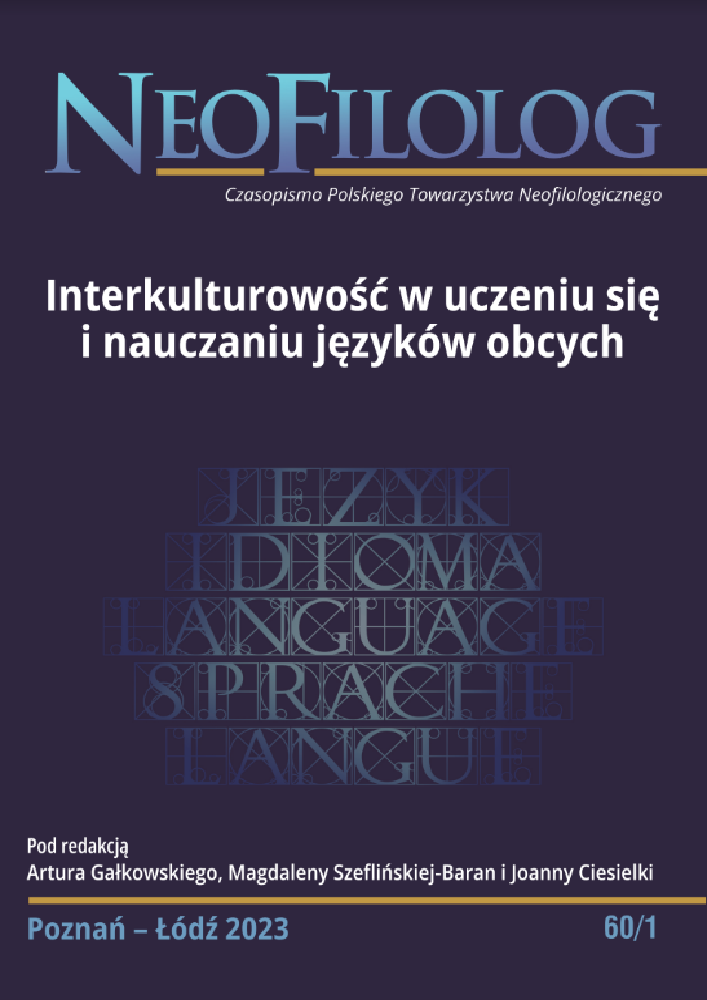Abstrakt
This article attempts to characterize three textbooks for learning the language of business and economics in terms of the presence of elements developing intercultural competences. Two textbooks for learning Italian and one for learning English were analyzed: (1) Italiano per economisti, (2) L'italiano in azienda, (3) Market Leader. Intermediate business English. The above-mentioned titles were published in the years 2002-2003, which allowed to eliminate possible differences resulting from the changing over time approach to the phenomenon of intercultural language education.
The aim of the study is to identify the elements developing intercultural competences, their qualitative and quantitative characteristics, to discuss the differences in the approach in Italian and English-language texts and to indicate the possibility of using selected solutions in the new teaching materials. This is important as research shows that contacts with foreign cultures alone do not naturally lead to the development of intercultural competence (Sobkowiak, 2015: 64, Budzanowska-Drzewiecka and Motyl-Adamczyk, 2016: 56).
The analysis covered non-verbal communication (gestures), stereotypes, proverbs and sayings, rules of linguistic politeness. From the glottodidactic point of view, the proposed types of exercises and the connection of (inter)cultural competences with other communicative competences will be analyzed.
The main hypothesis verified during the analyzes assumes that the concept of intercultural language education, although it does not appear as a notion on the pages of textbooks, is an important component of the didactic process in materials for learning the business language, and the approach to interculturality may differ depending on the target culture and status of the foreign language taught (Italian vs English, modern lingua franca).
Bibliografia
Balboni P. E. (2006), Intercultural communicative competence: a model. Perugia: Guerra Edizioni.
Bartmiński J. (2007), Stereotypy mieszkają w języku. Studia etnolingwistyczne. Lublin: Wydawnictwo UMCS.
Byram M. (2012), Reflecting on teachnig „culture” in foreing language education, (w:) Newby D. (red.), Insights into the European Portfolio for Student Teachers of Languages (EPOSTL). Newcastle upon Tyne: Cambridge Scholars Publishing.
Damen L. (1987). Culture Learning: The Fifth Dimension in the Language Classroom. Reading, MA: Addison–Wesley Publishing Company.
Kramsch C. (2011), The symbolic dimensions of the intercultural. „Language Teaching”, nr 44/3, s. 354–367. DOI: https://doi.org/10.1017/S0261444810000431
Ladegaard H. J., Jenks Ch. J. (2015), Language and intercultural communication in the workplace: critical approaches to theory and practice. „Language and Intercultural Communication”, nr 15/1, s. 1–12. DOI: https://doi.org/10.1080/14708477.2014.985302
Marcjanik M. (2013), Grzeczność w komunikacji językowej. Warszawa: Wydawnictwo Naukowe PWN.
Skulski P. (2020), Cultures – definitions, subjects, typologies, (w:) Skulski P. (red.), Cultural aspects of international business. Wrocław: Publishing House of Wrocław University of Economics and Business, s. 13–35.
Sobkowiak P. (2015), Interkulturowość w edukacji językowej. Poznań: Wydawnictwo Naukowe UAM.
Wierzbicka A. (1999), Emocje. Język i “skrypty kulturowe”, (w:) Bartmiński J. (red.), Język – umysł – kultura. Warszawa: Wydawnictwo Naukowe PWN, s. 163–191.
Cotton D., Falvey D., Kent S. (2002), Market Leader. Intermediate business English. Course Book. Essex: Pearson Education Limited.
Incalcaterra-McLoughlin L., Pla-Lang L., Schiavo-Rotheneder G. (2003), Italiano per economisti. Firenze: Alma Edizioni.
Pelizza G., Mezzadri M. (2002), L’italiano in azienda. Perugia: Guerra Edizioni.
Licencja
Prawa autorskie (c) 2023 Joanna Ozimska

Utwór dostępny jest na licencji Creative Commons Uznanie autorstwa – Bez utworów zależnych 4.0 Międzynarodowe.
Przedstawiany utwór (artykuł) upubliczniany jest na podstawie umowy z autorem i na licencji Creative Commons Attribution-NoDerivatives 4.0 International (CC BY-ND 4.0).
Użytkownicy mają obowiązek podania wraz z rozpowszechnionym utworem, informacji o autorstwie, tytule, źródle (odnośniki do oryginalnego utworu, DOI) oraz samej licencji;
- bez tworzenia utworów zależnych,
- utwór musi być zachowany w oryginalnej postaci.
Uniwersytet im. Adama Mickiewicza w Poznaniu zachowuje prawo do czasopisma jako całości (układ, forma graficzna, tytuł, projekt okładki, logo itp.).

